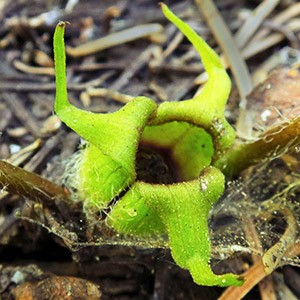Asarum caudatum
Asarum wagneri
British Columbia wildginger, creeping wild ginger, long-tail wild ginger, western wild ginger, wild ginger
green-flower wild ginger, long-tail wild ginger, wagner's wild ginger
horizontal, shallow, internodes (0.5-)1.5-6.5 cm.
horizontal, ± deeply buried, internodes 0.5-2.1 cm.
blade not variegate, cordate, 3-8.5 × 4.5-12 cm, apex usually obtuse, occasionally broadly acute;
surfaces abaxially sparsely appressed-hirsute, at least proximally, adaxially glabrous or sparsely appressed-hirsute, marginal hairs perpendicular to margin or curved toward apex.
blade not variegate, broadly reniform to cordate-reniform, 3-8 × 4-11 cm, apex obtuse to rounded (broadly acute);
surfaces abaxially sparsely hirsute, adaxially sparsely hirsute only along veins, marginal hairs mostly curved toward apex.
horizontal;
peduncle 1.5- calyx tube cylindric, externally brown-purple, rarely greenish, hirsute, internally white, usually with median purple stripe, with usually purple, rarely white hairs;
distal portion of sepal spreading or weakly (rarely strongly) reflexed at anthesis, (11-)30-75 mm, apex filiform-attenuate, abaxially purple or greenish, sparsely hirsute, adaxially purple, puberulent with crisped purple hairs;
pollen sacs 1.5-2 mm, sterile tip of connective on inner stamens purple, 0.5-1 mm, shorter than pollen sacs.
erect or ascending;
peduncle 0.8- calyx tube subglobose to cylindric-urceolate or urceolate, externally light green, sparsely to moderately hirsute, internally white or light green, bordered and occasionally striped with purple, with purple hairs;
distal portion of sepal spreading perpendicularly from base at anthesis, bent abruptly upward at midpoint, 8-20 mm, apex filiform-acuminate, abaxially white to pale green, sparsely villous to villous, adaxially white or light green, at least distally, bordered with purple and occasionally with purple band across base, puberulent with crisped purple-tipped hairs;
pollen sacs 1-2 mm, sterile tip of connective on inner stamens dark red, 0.25-1 mm, shorter than pollen sacs.
= 26.
Asarum caudatum
Asarum wagneri
In most populations of Asarum caudatum, the distal portion of the sepal is spreading or weakly reflexed and 30-75 mm. A single population south of Mt. Shasta, California, has the distal sepals strongly reflexed and unusually short, often as little as 1.1 cm. Flowers of these plants superficially resemble those of A. lemmonii; they differ in being horizontal, not descending as in A. lemmonii, and in the filiform-attenuate sepals.
Native Americans used Asarum caudatum medicinally to treat headaches, intestinal pain, knee pain, indigestion, boils, tuberculosis, and colic, and as a general tonic (D. E. Moerman 1986).
(Discussion copyrighted by Flora of North America; reprinted with permission.)
Asarum wagneri is endemic to the Cascade Range of pouthern Oregon (K. L. Lu and M. R. Mesler 1983).
(Discussion copyrighted by Flora of North America; reprinted with permission.)
- Local floras:
BC,
CA,
OR,
WA
- Local Web sites:
CalFlora,
CalPhotos,
Flora NW,
PNW Herbaria,
Turner Photog.
WildflowerSearch
iNaturalist (observations)
USDA Plants Database
- LBJ Wildflower Center
- SEINet
- Plants of the World Online
- Encyclopedia of Life
- Wikipedia
- Google Image Search
